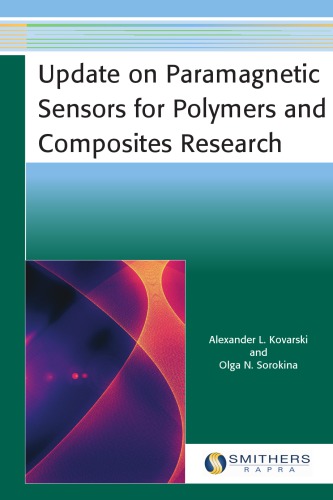

Most ebook files are in PDF format, so you can easily read them using various software such as Foxit Reader or directly on the Google Chrome browser.
Some ebook files are released by publishers in other formats such as .awz, .mobi, .epub, .fb2, etc. You may need to install specific software to read these formats on mobile/PC, such as Calibre.
Please read the tutorial at this link. https://ebooknice.com/page/post?id=faq
We offer FREE conversion to the popular formats you request; however, this may take some time. Therefore, right after payment, please email us, and we will try to provide the service as quickly as possible.
For some exceptional file formats or broken links (if any), please refrain from opening any disputes. Instead, email us first, and we will try to assist within a maximum of 6 hours.
EbookNice Team

Status:
Available4.7
36 reviews
ISBN 10: 184735775X
ISBN 13: 978-1847357755
Author: Olga N Sorokina , Alexander L Kovarski
Paramagnetic (or spin) sensors have found wide use in structural and dynamic research of condensed media using the spectroscopy of electron paramagnetic resonance (EPR). Stable nitroxide radicals are the most exploited paramagnetic sensors which formed the basis of spin probes and labels technique well known to the experts in fields of chemical and biological materials science.
With the proliferation of new materials (composites, nano-dimensional fillers) new trends in the methodology of paramagnetic sensors application have been outlined. This book is devoted to these new trends in polymers and nanocomposites research. It observes the methods of adaptation of EPR spectroscopy of paramagnetic sensors to interface layers investigation, analysis of the systems containing magnetic nanoparticles, identification of composites ingredients by EPR spectra of free radicals, detection of the shear component of polymer materials deformation.
This book also presents, at an accessible level, the theory of EPR, the structure and properties of paramagnetic sensors - stable nitroxide radicals and methods of basic parameters calculation from their EPR spectra.
Intended for researchers and educators specialized in polymer material science and colloid chemistry. This book can also be used as a practical guide on paramagnetic resonance and paramagnetic sensors application for students and postgraduates.
1. Electron Paramagnetic Resonance.
1.1 Paramagnetic Substances..
1.2 Resonance Conditions
1.3 Structure of Electron Paramagnetic Resonance Spectra.
1.4 Parameters of the Lines of Electron Paramagnetic Resonance Spectra
1.5 Construction of an Electron Paramagnetic Resonance Spectrometer
1.6 Experimental Procedures
1.6.1 Standard Samples
References
2. Spin Probes and Labels Method
2.1 Structure and Properties of Stable Nitroxide Radicals.
2.2 EPR Spectra of SNR and Calculation of the Main Parameters
2.2.1 Change of Spectra due to Rotational Dynamics of Stable Nitroxide Radicals
2.2.2 Dependence on Particle Size and Viscosity of the Environment for Rotational Correlation Times of Stable Nitroxide Radicals
2.2.3 Electron Paramagnetic Resonance Spectra at Anisotropic Rotation of Stable Nitroxide Radicals
2.2.4 Analyses of the Electron Paramagnetic Resonance Spectra of Stable Nitroxide Radicals in Heterogeneous Media
References
3. Study of Interface Layers in Filled Polymers by Paramagnetic Sensors
3.1 Experimental Procedures.
3.1.1 Covalent Bonding of Nitroxide Radicals with Filler Surface
3.1.2 Nitroxide Radicals Adsorbed on Surfaces
3.1.3 Nitroxide Radicals as Spin Probes
3.2 Factors Determining the Molecular Mobility of Labels Located on the Solid Surface
3.2.1 Dynamics of Spin Labels in Liquid Media.
3.2.2 Radicals Adsorbed by the Surface
3.2.3 Role of Structure and Specific Surface of the Filler
3.3 Application of the Method for Specific Polymer Tasks Solution
3.3.1 Molecular Dynamics of Interface Layers in Amorphous Polymers.
3.3.2 Criteria of Formation of an Adsorption Layer and Research of its Defects.
3.3.3 Evaluation of the 'Long-range Action' of the Solid Filler Surface and Thickness of the Interface Layer
3.3.4 Research of the Curing of Filled Resins.
3.3.5 Investigation of Selective Adsorption of Macromolecules from Solution
3.4 Investigation of Crystalline Polymers.
3.4.1 Effect of the Molecular Weight of the Polymer.
3.4.2 Temperature Functions of Molecular Mobility.
References
4. Study of the Adsorption of Macromolecules on Magnetic Nanoparticles
4.1 General Approach.
4.2 Application of this Method
References
5. Study of Dispersions of Ferromagnetic Nanoparticles.
5.1 Outline of the Theory of Electron Paramagnetic Resonance Spectra Line Shape
5.2 Features of Electron Paramagnetic Resonance Spectra of Paramagnetic Sensors in Magnetic Dispersions
5.2.1 Line Shift.
5.2.2 Line Broadening.
5.2.3 Line Shape..
5.3 Theory of Paramagnetic Sensor Line Shape in the Presence of Extended Magnetic Objects..
5.4 Results of the Research of Magnetic Sols and Gels
References
6. Arylindandions as Specific Sensors of Shear Strain in Polymers
6.1 Formation of Arylindandions Free Radicals under Normal Pressure
6.2 Formation of Arylindandions Free Radicals under High Pressure and Shear Deformation
References
7. Qualitative and Quantitative Analyses of Polymer Composites by Electron Paramagnetic Resonance.
7.1 Units and Conversion Factors
7.2 Generation of Free Radicals
7.3. Experimental Procedure.
7.4 Electron Paramagnetic Resonance Spectra of
Free Radicals in Polymers.
7.4.1 Hydrocarbon Polymers
7.4.2 Oxygen-containing Polymers
7.4.3 Nitrogen-containing Polymers.
7.4.4 Chlorine-containing Polymers.
7.4.5 Fluorine-containing Polymers
7.4.6 Sulfur-containing Polymers..
7.4.7 Silicon-containing Polymers
7.4.8 Semiconducting Polymers...
7.5 Electron Paramagnetic Resonance Spectra of Polymer Fillers
7.5.1 Silica
7.5.2 Glass
7.5.3 Carbonic Materials
7.5.4 Asbestos.
7.5.5 Cement.
7.6 Analyses of Polymers by the Spin Probe Method....
what is paramagnetic mean
paramagnetic orbital diagram
update on paxlovid
is paramagnetic magnetic
what is paramagnetic or diamagnetic
Tags: Olga N Sorokina, Alexander L Kovarski, Update on Paramagnetic, Polymers and Composites